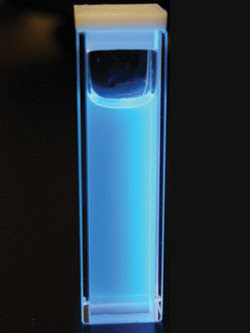Before Jeffrey J. Urban began studies on the concentration, separation and sequestration of carbon, he was greeted with a big surprise. Prior to performing physical characterization, he did “the chemical step,” which, in this case, meant looking at the absorption emission spectra of magnesium oxide.
The surprise, he said, was the discovery that MgO (magnesium oxide) nanocrystals have bright blue photoluminescent properties (bulk MgO is a nonemissive, wide-bandgap insulator).
He obtained absorption spectra with a UV-3600 UV-VIS-NIR spectrophotometer from Shimadzu Scientific Instruments of Columbia, Md., and recorded photoluminescence spectra on a Fluorolog 3 spectrofluorometer from Horiba Jobin Yvon of Longjumeau, France. He used an integrating sphere to measure absolute quantum yields.

An intense blue photoluminescence is emitted when nanocrystals of magnesium oxide are excited by UV light. Courtesy of Dr. Hoi Ri Moon, Lawrence Berkeley National Laboratory.
Urban, a staff scientist at Lawrence Berkeley National Laboratory in California and a member of the new Energy Frontier Research Center for Nanoscale Control of Geologic CO2, said that the finding is significant because solid-state blue light has been difficult to produce – a major challenge to the solid-state lighting industry because it takes red, green and blue to make white.
After finding that MgO nanocrystals provide a stable blue dye, researchers at the Inorganic Nanostructures Facility at the lab’s nanoscience research center discovered a mechanism for controlling the size of the nanocrystals. Their work may provide a source of inexpensive bright-blue luminescence in bioimaging, solid-state lighting or other applications.
Carbon capture
After step one of Urban’s research unleashed a whole new body of investigation, he moved on to the next steps involved in using MgO nanoparticles and other minerals that help form carbonate minerals when CO2 is pumped underground. Successful sequestration of carbon requires the ability to seal geochemical reservoirs deep below the Earth’s surface without allowing gases or fluids to escape.
He noted that the carbon storage the investigators are modeling is really not unlike that which occurs in nature when sea coral captures and stores CO2. The nanocrystals grown at the lab provide a simple model that enables them to study the process.
Although every scientist hopes that his or her work will have a positive impact, Urban said, he believes that his group’s work will provide some of the “detailed physical constants that help us model these processes.”